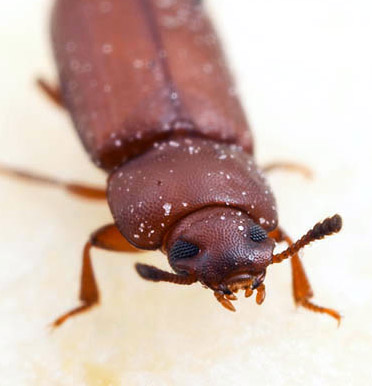
The genome of the red flour beetle Tribolium castaneum was published today in Nature. This latest insect genome is interesting not for what it says about beetles but for what it says about another model species, the venerable fruit fly. The more we learn about other insect genomes- the honeybee, the mosquito, and now the flour beetle- the more we see that the famed Drosophila fruit fly is an odd little beast. The bee and now the beetle, it turns out, are both rather normal. They share a lot of proteins with mammals, and fish, and other animals we know about. Fruit flies, not so much. While we all understand that the fruit fly has a number of great qualities for lab breeding and chromosome work and blah blah blah fruit flies blah blah blah (sorry, can't help it), its genome is so very divergent that it becomes hard to know to what we can legitimately apply our immense accumulated knowledge of fruit fly biology, other than other fruit flies. It is an unfortunate choice for a model organism.
On a personal note, we at the Beetle Tree of Life project are forever indebted to the Tribolium genome people. Many of the genes that we work with were only developed because the Tribolium researchers have been making their data available. Their output has made my life the last couple years a lot easier. If any of the Tribolium folks ever come through Tucson, I'll happily buy them a beer.
In any case, here's the paper: Tribolium Genome Sequencing Consortium. 2008. The genome of the model beetle and pest Tribolium castaneum. Nature; advance online publication 23 March 2008 | doi:10.1038/nature06784.
ABSTRACT:Tribolium castaneum is a member of the most species-rich eukaryotic order, a powerful model organism for the study of generalized insect development, and an important pest of stored agricultural products. We describe its genome sequence here. This omnivorous beetle has evolved the ability to interact with a diverse chemical environment, as shown by large expansions in odorant and gustatory receptors, as well as P450 and other detoxification enzymes. Development in Tribolium is more representative of other insects than is Drosophila, a fact reflected in gene content and function. For example, Tribolium has retained more ancestral genes involved in cellâcell communication than Drosophila, some being expressed in the growth zone crucial for axial elongation in short-germ development. Systemic RNA interference in T. castaneum functions differently from that in Caenorhabditis elegans, but nevertheless offers similar power for the elucidation of gene function and identification of targets for selective insect control.

thank you
i am interesting in information about insects life